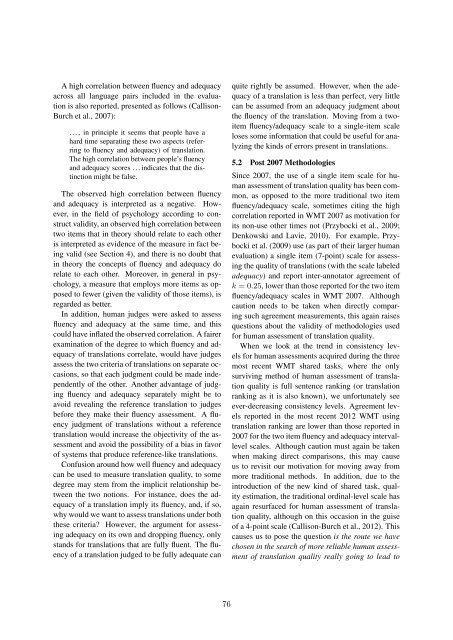Full proceedings volume - Australasian Language Technology ...
Full proceedings volume - Australasian Language Technology ...
Full proceedings volume - Australasian Language Technology ...
You also want an ePaper? Increase the reach of your titles
YUMPU automatically turns print PDFs into web optimized ePapers that Google loves.
A high correlation between fluency and adequacy<br />
across all language pairs included in the evaluation<br />
is also reported, presented as follows (Callison-<br />
Burch et al., 2007):<br />
. . . , in principle it seems that people have a<br />
hard time separating these two aspects (referring<br />
to fluency and adequacy) of translation.<br />
The high correlation between people’s fluency<br />
and adequacy scores . . . indicates that the distinction<br />
might be false.<br />
The observed high correlation between fluency<br />
and adequacy is interpreted as a negative. However,<br />
in the field of psychology according to construct<br />
validity, an observed high correlation between<br />
two items that in theory should relate to each other<br />
is interpreted as evidence of the measure in fact being<br />
valid (see Section 4), and there is no doubt that<br />
in theory the concepts of fluency and adequacy do<br />
relate to each other. Moreover, in general in psychology,<br />
a measure that employs more items as opposed<br />
to fewer (given the validity of those items), is<br />
regarded as better.<br />
In addition, human judges were asked to assess<br />
fluency and adequacy at the same time, and this<br />
could have inflated the observed correlation. A fairer<br />
examination of the degree to which fluency and adequacy<br />
of translations correlate, would have judges<br />
assess the two criteria of translations on separate occasions,<br />
so that each judgment could be made independently<br />
of the other. Another advantage of judging<br />
fluency and adequacy separately might be to<br />
avoid revealing the reference translation to judges<br />
before they make their fluency assessment. A fluency<br />
judgment of translations without a reference<br />
translation would increase the objectivity of the assessment<br />
and avoid the possibility of a bias in favor<br />
of systems that produce reference-like translations.<br />
Confusion around how well fluency and adequacy<br />
can be used to measure translation quality, to some<br />
degree may stem from the implicit relationship between<br />
the two notions. For instance, does the adequacy<br />
of a translation imply its fluency, and, if so,<br />
why would we want to assess translations under both<br />
these criteria? However, the argument for assessing<br />
adequacy on its own and dropping fluency, only<br />
stands for translations that are fully fluent. The fluency<br />
of a translation judged to be fully adequate can<br />
quite rightly be assumed. However, when the adequacy<br />
of a translation is less than perfect, very little<br />
can be assumed from an adequacy judgment about<br />
the fluency of the translation. Moving from a twoitem<br />
fluency/adequacy scale to a single-item scale<br />
loses some information that could be useful for analyzing<br />
the kinds of errors present in translations.<br />
5.2 Post 2007 Methodologies<br />
Since 2007, the use of a single item scale for human<br />
assessment of translation quality has been common,<br />
as opposed to the more traditional two item<br />
fluency/adequacy scale, sometimes citing the high<br />
correlation reported in WMT 2007 as motivation for<br />
its non-use other times not (Przybocki et al., 2009;<br />
Denkowski and Lavie, 2010). For example, Przybocki<br />
et al. (2009) use (as part of their larger human<br />
evaluation) a single item (7-point) scale for assessing<br />
the quality of translations (with the scale labeled<br />
adequacy) and report inter-annotator agreement of<br />
k = 0.25, lower than those reported for the two item<br />
fluency/adequacy scales in WMT 2007. Although<br />
caution needs to be taken when directly comparing<br />
such agreement measurements, this again raises<br />
questions about the validity of methodologies used<br />
for human assessment of translation quality.<br />
When we look at the trend in consistency levels<br />
for human assessments acquired during the three<br />
most recent WMT shared tasks, where the only<br />
surviving method of human assessment of translation<br />
quality is full sentence ranking (or translation<br />
ranking as it is also known), we unfortunately see<br />
ever-decreasing consistency levels. Agreement levels<br />
reported in the most recent 2012 WMT using<br />
translation ranking are lower than those reported in<br />
2007 for the two item fluency and adequacy intervallevel<br />
scales. Although caution must again be taken<br />
when making direct comparisons, this may cause<br />
us to revisit our motivation for moving away from<br />
more traditional methods. In addition, due to the<br />
introduction of the new kind of shared task, quality<br />
estimation, the traditional ordinal-level scale has<br />
again resurfaced for human assessment of translation<br />
quality, although on this occasion in the guise<br />
of a 4-point scale (Callison-Burch et al., 2012). This<br />
causes us to pose the question is the route we have<br />
chosen in the search of more reliable human assessment<br />
of translation quality really going to lead to<br />
76














